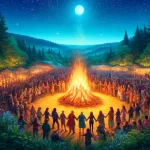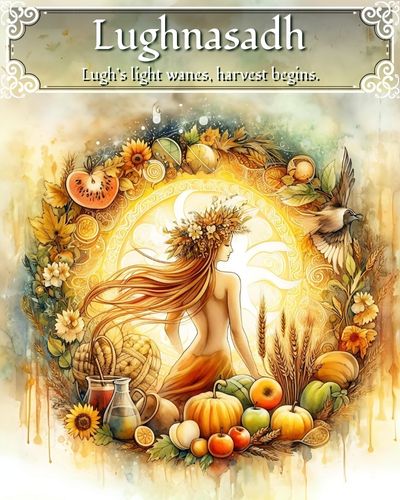
Approx. Reading time: About 12 Minutes

Introduction
Unveiling the Ancient Anglo-Saxon Goddess: Hlæfdige and the Harvest
Hlæfdige, the Lady of the Loaf, is a lesser-known figure in folklore and mythology who holds a significant place in the celebration of Lammas, also known as Lughnasadh. Lammas, which falls on August 1st, marks the beginning of the harvest season and is a time of gratitude and celebration for the bountiful gifts of the earth. In this article, we will explore the fascinating origins of Hlæfdige and her relation to the traditions and rituals of Lammas.

Hlæfdige: Embodying the Nourishing Power of Grain
In the realm of ancient Anglo-Saxon beliefs, Hlæfdige emerges as a revered figure, embodying the essence of the nourishing power of grain. Translated as the “Lady of the Loaf” or the “Bread Lady,” she is deeply associated with the harvest season and the abundant sustenance that stems from the earth’s fertile embrace. Hlæfdige encapsulates the spirit of abundance, acting as a beacon of prosperity and the life-sustaining force inherent in grain.
Depicted as a matronly figure, Hlæfdige exudes an air of maternal care and nourishment. Adorned with golden wheat sheaves, her regal presence celebrates the vibrant and fruitful harvest that is made possible through the earth’s fertility. The wreath of wildflowers crowning her head further symbolizes the blossoming abundance and the interconnectedness between nature’s bounties and the cycle of life.
Hlæfdige’s association with grain goes beyond its physical form. She represents the transformative power of this vital crop, where seeds are sown and nurtured by the earth, eventually culminating in the golden abundance that sustains communities. As the “Lady of the Loaf,” she personifies the alchemical process of turning harvested grain into nourishing sustenance, fueling, and nurturing the lives of those who partake in its gifts.
Furthermore, Hlæfdige’s embodiment of the nourishing power of grain extends to the spiritual and symbolic realms. Grain, a staple food, has long been revered as a source of sustenance and survival. Its cultivation and harvest require the collective efforts of communities, symbolizing the interdependence between humans and the earth. Hlæfdige serves as a reminder of the sacred bond between humanity and the natural world, underscoring the importance of valuing and respecting the earth’s gifts.
During the celebration of Lammas, Hlæfdige’s presence is invoked to honor and express gratitude for the blessings of the harvest season. Through rituals and offerings, individuals pay homage to her, recognizing the life-giving force embodied in grain and the interconnectedness between human nourishment and the earth’s fertility. Hlæfdige’s role as the guardian of the grain and the provider of sustenance encourages a deeper appreciation for the abundance that surrounds us and reinforces the need to cherish and protect the delicate balance of nature’s cycles.
As we celebrate Lammas and embrace the teachings of Hlæfdige, we are reminded of the profound nourishment that stems from the earth’s fertile generosity. We recognize the transformative power of grain and the interconnectedness between human sustenance and the abundance of the natural world. Hlæfdige, the embodiment of the nourishing power of grain, invites us to embrace gratitude, reverence, and a harmonious relationship with the land, fostering a deepened connection with the cycles of life and the bountiful blessings that sustain us.
The Guardian of the Harvest
Hlæfdige’s Role in Lammas Celebrations
As Lammas, the festival of the first harvest, unfolds, Hlæfdige takes center stage, her presence invoked to honor and express gratitude for the abundant blessings bestowed upon the land. In this joyous celebration, she assumes the vital role of the guardian and provider of grain—the very essence that forms the foundation of the staple food: bread. Hlæfdige, known as the Lady of the Loaf, symbolizes the transformative power of grain as it is milled, kneaded, and ultimately baked into nourishing sustenance for the community. It is through her grace and abundance that the people find sustenance and rejoice in the fruits of the harvest.
Hlæfdige’s significance during Lammas is rooted in her association with the sacred grain, which serves as a vital source of sustenance and nourishment. As the guardian of the harvest, she oversees the well-being of the crops, ensuring a plentiful yield and a bountiful harvest. In this role, she embodies the spirit of fertility and abundance, guiding the agricultural endeavors that sustain the community’s livelihood.
The transformative power of grain lies at the heart of Hlæfdige’s representation as the Lady of the Loaf. The journey from seed to loaf is a testament to the cyclical nature of life and the transformative process of nourishment. Grain, once harvested, undergoes a series of laborious steps: it is milled into flour, then lovingly kneaded, and shaped into dough before being baked into bread. Hlæfdige personifies this alchemical process, embodying the transformative energy that turns the humble grain into a vital source of sustenance.
As Lammas celebrations unfold, rituals and customs centered around Hlæfdige bring communities together in the age-old tradition of breadmaking. The sacred grain associated with Hlæfdige is harvested, ground into flour, and transformed into various bread and pastry offerings. These offerings are crafted with love and intention, reflecting the gratitude for the abundance of the harvest and the desire to share in the communal celebration. Hlæfdige’s benevolent presence infuses the baking process with her grace and blessings, ensuring that the bread becomes a symbol of nourishment, unity, and abundance.
In Lammas ceremonies, loaves of bread take on sacred significance. They are shaped and adorned with intricate designs representing the sun, sheaves of wheat, and other symbols of fertility and prosperity. These beautifully crafted loaves serve as offerings to Hlæfdige, a testament to the community’s gratitude and reverence for the grain’s transformative power. Sharing the bread with loved ones and the community further strengthens the bond of kinship and fosters a sense of unity and abundance.
Hlæfdige’s role in Lammas celebrations is not confined to the physical act of breadmaking. She embodies the spirit of generosity, sustenance, and interconnectedness. Beyond the nourishment provided by the bread, she represents the underlying interdependence between humans and the natural world. Her presence reminds us to honor the gifts of the earth, to cultivate a respectful relationship with the land, and to recognize the efforts of all those involved in the agricultural process.
As Lammas unfolds each year, Hlæfdige’s role as the Guardian of the Harvest remains steadfast. She serves as a guiding force, reminding us to honor and express gratitude for the blessings of the harvest and the transformative power of grain. Through her presence, we are invited to celebrate the abundance, unity, and interconnectedness that arise from the sacred relationship between humanity and the bountiful earth.
Breadmaking Rituals
Honoring Hlæfdige’s Sacred Grain
Recipe: Hlæfdige Lady of Loaf’s Sacred Bread
At Lammas, the celebration of the first harvest, an ancient tradition is reignited as families and communities unite in the timeless ritual of breadmaking, paying homage to Hlæfdige and her sacred grain. This cherished custom forms the heart of Lammas festivities, as wheat—the grain associated with Hlæfdige—is harvested, milled into flour, and skillfully transformed into an array of bread and pastry offerings. Infused with love and intention, these creations embody a profound sense of gratitude for the abundant harvest and a profound desire to partake in the communal celebration.
Breadmaking rituals associated with Hlæfdige during Lammas offer a deeply meaningful experience, invoking the transformative power of grain and honoring the spirit of the Lady of the Loaf. As families and communities gather, they embark on a sacred journey that begins with the harvesting of wheat, symbolizing the culmination of a season’s toil and the promise of sustenance.
The harvested wheat, carefully gathered and prepared, undergoes the ancient process of milling, where it is transformed into flour. This pivotal step symbolizes the extraction of life-giving nourishment from the grain, representing Hlæfdige’s divine influence in bringing forth abundance and sustenance for the community.
With flour in hand, the art of breadmaking unfolds. Hands skillfully knead the dough, imbuing it with love, care, and intention. The rhythmic motion echoes the age-old connection between humans and the land, as the transformative process captures the essence of Hlæfdige’s presence. Each stretch, each fold, and each rise of the dough becomes a testament to the interconnectedness between the sacred grain and the communal celebration of Lammas.
As the bread and pastries take shape, they become tangible expressions of gratitude and reverence. Decorated with intricate designs symbolizing fertility, prosperity, and the cycles of nature, these offerings reflect the shared appreciation for the abundance bestowed upon the community. The act of creating these breads with love and intention deepens the connection to Hlæfdige, recognizing her as the provider of sustenance and the embodiment of the grain’s transformative power.
During Lammas celebrations, these beautifully crafted loaves and pastries find their place on altars, serving as offerings to Hlæfdige. They become conduits of gratitude, inviting her presence and blessings into the festivities. The act of sharing the bread with loved ones and the wider community further amplifies the spirit of unity and abundance, fostering a deep sense of kinship and connection.
Through the breadmaking rituals, Lammas becomes a time of reverence, gratitude, and celebration. It serves as a reminder of the sacred bond between humanity and the nourishing power of grain, personified by Hlæfdige. These rituals not only honor the abundance of the harvest but also reinforce the interconnectedness between individuals, communities, and the land that sustains them.
As modern interpretations of Lammas continue to evolve, the tradition of breadmaking remains a timeless practice. It provides an opportunity to reconnect with Hlæfdige’s sacred grain, to express gratitude for the bountiful harvest, and to partake in a communal celebration that transcends time and cultural boundaries. Through these breadmaking rituals, Hlæfdige’s presence is honored, and her transformative power is celebrated, reminding us of the enduring connection between nourishment, gratitude, and the vibrant spirit of Lammas.
Symbolism in Shaping and Decorating
Offering Bread to Hlæfdige
A central aspect of Lammas celebrations lies in the artful shaping and intricate decoration of bread, an act steeped in symbolism that honors Hlæfdige and seeks her blessings for a bountiful harvest and a prosperous future. As families and communities come together to commemorate this sacred occasion, the breadmaking process transforms into a meaningful expression of gratitude and reverence.
During Lammas, loaves of bread take on symbolic forms, each design carefully crafted to reflect the essence of the season. Among the most prevalent symbols are representations of the sun, a potent emblem of warmth, light, and life-giving energy. By shaping bread into sun-like forms, worshippers pay homage to the divine force that nurtures and ripens the crops, infusing them with vitality and abundance.
In addition to the sun, sheaves of wheat, an ancient symbol of prosperity and fertility, hold a special place in the bread-shaping rituals. Wheat, the sacred grain associated with Hlæfdige, takes center stage in these offerings, embodying the life-sustaining essence of the harvest. As the wheat gracefully sways in the fields, it serves as a testament to the cycles of life, the interconnectedness of all living beings, and the bountiful blessings bestowed upon the land.
The bread, transformed into shapes of sun and wheat, is then lovingly placed on altars or presented as offerings to Hlæfdige. This act signifies the deep gratitude and reverence felt towards the goddess, acknowledging her role as the guardian and provider of the grain that forms the foundation of nourishment. As the loaves are laid before her, they become vessels of appreciation, inviting her divine presence into the festivities, and bestowing her blessings upon the community.
The act of sharing the bread with loved ones and the wider community adds yet another layer of symbolism to the Lammas celebrations. As each person partakes in the bread, they become connected not only to the nourishing sustenance but also to the spirit of unity and abundance that Hlæfdige embodies. This act of communal sharing strengthens the bond of kinship, fostering a sense of togetherness and gratitude for the blessings bestowed upon all.
In shaping and decorating bread for Hlæfdige during Lammas, worshippers engage in a sacred art that transcends mere aesthetics. The symbolism woven into the bread’s form and decoration serves as a language of reverence, expressing a profound connection to the cycles of nature and the generous spirit of the harvest. As modern celebrations continue to evolve, these meaningful traditions endure, reminding us of the enduring bond between humanity, the land, and the nourishing power of Hlæfdige’s sacred grain.
Nourishment and Interconnectedness
Hlæfdige’s Deeper Meaning
While the rituals and offerings associated with Hlæfdige during Lammas are captivating, the essence of this ancient Anglo-Saxon goddess extends far beyond the physical act of breadmaking. Hlæfdige represents a profound understanding of the nourishment and sustenance that flows not only from the grain but also from the intricate web of interconnectedness between humans and the natural world.
At the heart of Hlæfdige’s teachings lies a deep appreciation for the earth’s gifts and the delicate balance that sustains life. She calls upon us to recognize the intrinsic value of the land, to cherish its abundance, and to tread upon it with respect and reverence. In doing so, we acknowledge the profound interdependence between humans and the natural world, understanding that our own well-being is intricately linked to the health and vitality of the earth.
Through Hlæfdige’s teachings, we are reminded of the efforts and dedication of those involved in the agricultural process. The farmers, laborers, and all who toil on the land become part of a sacred dance, working in harmony with the cycles of nature to bring forth the harvest. Hlæfdige urges us to acknowledge their contributions and recognize the significance of their labor in providing the nourishment that sustains us all.
Moreover, Hlæfdige encourages us to extend our gratitude beyond the physical sustenance provided by the grain. She teaches us to nourish our souls through acts of kindness, compassion, and connection. By valuing the earth’s gifts and embracing the interconnectedness of all living beings, we cultivate a deeper sense of empathy and appreciation for the world around us.
In our modern world, where the pace of life often disconnects us from the rhythms of nature, Hlæfdige’s teachings are more relevant than ever. She calls upon us to pause, to listen to the whispers of the earth, and to find solace in the nourishment provided by the land. Through Hlæfdige’s wisdom, we are reminded to live in harmony with nature, embracing sustainable practices that preserve and protect the gifts of the earth for future generations.
As Lammas celebrations continue to evolve, Hlæfdige’s deeper meaning resonates with those seeking a profound connection with the natural world. Her teachings serve as a guide, urging us to look beyond the surface and recognize the interconnectedness of all life. By honoring Hlæfdige’s message, we nourish not only our bodies but also our spirits, fostering a deep sense of gratitude, respect, and harmony with the earth and its abundant blessings.
Hlæfdige in Modern Times
Reconnecting with Nature’s Abundance
In our fast-paced and modern world, the significance of Hlæfdige during Lammas remains as relevant as ever. As individuals strive to reconnect with nature’s cycles and express gratitude for the abundance in their lives, the presence of the Lady of the Loaf serves as a powerful reminder of our deep connection to the earth and the importance of honoring its gifts.
Today, where technology often distracts us from the natural world, Lammas and the invocation of Hlæfdige’s spirit offers an opportunity for introspection and realignment with the rhythms of nature. As we gather to celebrate this sacred occasion, we are invited to pause and reflect on the abundance that surrounds us—the bountiful harvests, the nourishing sustenance, and the interconnectedness of all living beings.
Hlæfdige’s teachings inspire us to honor the fruits of the earth, not only in the physical sense but also in our actions and choices. Through conscious living, sustainable practices, and mindful consumption, we can express our gratitude for the abundance we receive and acknowledge our role as stewards of the natural world. By embracing the spirit of generosity and sharing, we contribute to the collective well-being of humanity and foster a sense of unity and interdependence.
Moreover, Hlæfdige’s presence encourages us to recognize the interwoven tapestry of life, where every being and element has its place and purpose. She reminds us that we are part of a greater whole, intricately connected to the cycles of nature. By acknowledging and embracing this interdependence, we gain a deeper appreciation for the fragility and resilience of the earth, motivating us to protect and preserve its vitality for future generations.
In our pursuit of reconnection, we may find solace in nature’s embrace. Whether it is taking a walk in a lush forest, tending to a garden, or simply pausing to admire the beauty of a sunrise, these moments of communion with the natural world can nourish our souls and reignite a sense of wonder and gratitude.
Modern interpretations of Lammas and Hlæfdige’s significance provide an opportunity for individuals to embark on a journey of self-discovery and transformation. By embracing the wisdom of the Lady of the Loaf, we open ourselves to a deeper understanding of our place within the intricate tapestry of existence. We learn to live in harmony with nature’s rhythms, to celebrate its abundance with gratitude, and to cultivate a profound sense of interconnectedness that transcends time and culture.
As we continue to navigate the complexities of the modern world, Hlæfdige’s message acts as a guiding light, reminding us of the beauty and power of nature’s abundance. By embracing her teachings, we reclaim our innate connection to the earth, fostering a renewed sense of purpose, and finding fulfillment in living harmoniously with the cycles of life. May Hlæfdige’s spirit inspire us to nurture the interdependence between humans and the natural world, creating a future where gratitude, respect, and abundance flourish.
Hlæfdige and Lammas – Celebrating Abundance and Interdependence
As we come together to celebrate Lammas and honor the divine presence of Hlæfdige, let us carry forward the profound teachings she imparts. Let us remember the timeless wisdom she embodies—the wisdom of nourishment, abundance, and the sacred interdependence between the land and its people. May her presence continue to inspire us to cherish and protect the precious resources of the earth, to cultivate a spirit of gratitude and sharing, and to foster a harmonious relationship with the ever-turning cycles of life. As we embark on this journey of connection and reverence, may Hlæfdige’s guiding light illuminate our path, guiding us to a future where we live in harmony with nature, honoring the bountiful blessings that surround us.













